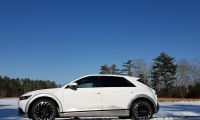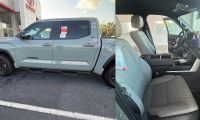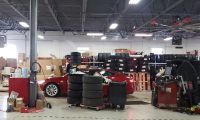Yesterday was National Plug-in Day (NPID), a nationwide celebration of electric vehicles organized by Plug-in America, the Electric Auto Association and the Sierra Club. On the eve of NPID, or more succinctly, on the eve of thousands of Nissan Leaf owners gathering face-face across the country, Nissan released an open letter concerning the battery capacity loss issue that is worrying Leaf owners. The latest letter is again an attempt to quell the fears of Leaf owners, but it appears that Leaf owners are starting to have a deaf ear for Nissan's communications on this matter.
The issue is that some Nissan Leaf owners are noticing diminished battery capacity. This lost capacity is measured in one of two ways: 1) when the Leaf is fully charged, the dashboard State of Charge will show fewer "bars" of capacity; 2) 3rd party instrumentation gauges which display battery charge in GID's. Diminished battery capacity generally means the Leaf has a shorter driving range, making it less useful as a car. Primarily the affected Leaf's are in hot climates like the Phoenix area, leading many to think the cause of battery capacity loss is the heat and blaming Nissan's choice to not have a cooling system. Nissan, in their responses in June, last week, and below, are focusing on the Phoenix and Arizona based Leaf owners. Not liking Nissan's responses, a large group of Nissan Leaf owners staged a massive test of Leaf battery capacity in Phoenix a bit over a week ago, and managed to measure some of the capacity loss. In the meantime, Coda Automotive is making the case for the thermal management system their engineers chose to use.
Nissan's latest letter (replicated below) reveals more about the company's investigation than had been revealed last week, but "more" is a relative term because there are many details left wanting.
When Nissan says "You are truly our best ambassadors to the next generation of passionate EV drivers," we should think back to July when it was beginning to sink in that Nissan Leaf sales this year were starting to be dismal. At that time loyal Leaf owners were brainstorming Nissan Leaf marketing ideas on the MyNissanLeaf forum. Today the MNL forum has a lot of worry about this battery capacity loss issue.
When Nissan says they identified seven Leaf owners in Phoenix, do we know for sure the issue is this limited? Browsing the MNL forum, there are many who do not live in hot climates who are suffering from diminished battery capacity. An example is Tony Williams who drove on the BC2BC trip (Baja California to British Columbia) in June, but there are others. The NPID event I attended in Silicon Valley had more than one person reporting diminished battery pack capacity. While these people have put a lot of miles on their Leaf's, Silicon Valley has neither hot nor cold weather.
Nissan says they "measured capacity, and conducted voltage testing on individual battery cells" which sounds nice, but what does it mean. Having built battery packs for electric motorcycles and cars, I can say that this cannot be done just by measuring the voltage of the battery pack and cells. Instead this test has to be a dynamic measurement over time, because lithium battery cells have largely the same voltage except when fully charged and fully discharged . To perform this test, Nissan's engineers will have had to completely charge and discharge each pack at least once to measure the amp-hours that can be pulled out, graphing the voltage the whole time.
Going by the discussion on MNL, Leaf owners are hearing Nissan say "nothing to see here, move along." What Nissan says in this letter is that the packs they tested are behaving as expected given the usage pattern of each individual vehicle. However, 2 years ago Nissan's promise in marketing literature was "80% remaining capacity after 5 years" without explaining nuances like the ambient temperature or the distance the car has been driven. It is a fair assumption for a Leaf owner to read "80% remaining capacity after 5 years" and think battery degradation will occur linearly over a set period of time. Nissan is trying to make the case, after the fact, in a way that looks suspicious to Leaf owners (going by discussion on MNL), that there are additional technical factors which were not disclosed to Leaf owners.
Indeed one of the MNL members suggested these disclosures by Nissan would help: 1. Produce an "ideal" speed/range chart that lets you know how fast/far you can travel on a single charge in a new car. All new cars should be able to match these numbers at a minimum. The data in NTB11-076a is not good enough, but it's a good start. 2. Provide guidelines on how capacity will be reduced over the warranty period based on where you live assuming typical usage (used as daily commuter, parked in sunny parking log, parked in garage, etc). 3. Provide guidelines on how tweaking usage habits may improve or reduce capacity loss over time. How does calendar life change when using 80% vs 100% charging? How does calendar life change when averaging 3.5 mi/kWh vs 4.5 mi/kWh?
Perhaps the most important part of this letter is the selection of Chelsea Sexton to lead an independent advisory board. Sexton has a long history of electric vehicle advocacy work, and was the co-star of the movie Who Killed the Electric Car (the 'leading man' was GM's EV1). Perhaps the role of this advisory board will be to keep Nissan honest. The discussion on the MNL forum today is full of distrust of Nissan, and the extreme nuances of Nissan's communication is not going down well with the Leaf owners. Sexton's history includes standing up to the automakers as an independent voice.
Additionally, a Nissan marketing communications leader, Jeff Kuhlman, Head of Global Communications for Nissan Motor Co., joined the MNL forum to directly talk with the community. His resume includes a long stint with GM where he worked on the EV1. He recognizes "it’s clear that [Nissan has] much work to do on the communications front," that "[Nissan has] been too silent on what Nissan is working on, what we think the future looks like, and what innovations are coming." The move is risky because, as Kuhlman notes, when a manufacturer directly engages the customer base in an "enthusiast forum" that "too often such efforts, while noble, [come] off as spin" and manufacturers prefer to monitor enthusiast forums and post responses through an "owned channel" like a youtube account or facebook page. Kuhlman recognizes "that the discussions will often be tough" but promises to bring Nissan people to the MNL forum for a direct conversation.
Source: OPEN LETTER TO THE LEAF COMMUNITY
From Carla BailoAdvertising Happy eve of National Plug In Day. We’re excited that Nissan LEAF owners are gathering nationally tomorrow to celebrate zero-emission motoring, and appreciate that so many of you are sharing your enthusiasm with others. You are truly our best ambassadors to the next generation of passionate EV drivers.
We also want to update you, the LEAF community, on our findings regarding battery capacity loss concerns expressed by a number of owners in the Phoenix market. Nissan takes customer concerns seriously, and we know many of you have been interested to hear what we’ve learned in our thorough investigation, and what it all means.
We identified seven LEAF owners in the Phoenix area who had reported concerns with their vehicles. With their agreement we brought the cars to Nissan’s Arizona test facility, where we removed the batteries for evaluation, measured capacity, and conducted voltage testing on individual battery cells. These tests were diagnostic only; no modifications were performed to the battery packs themselves.
After returning cars to their owners, we analyzed the results of our tests, with specific emphasis on the rate of actual capacity loss for each vehicle. Our goals were simple: to determine 1) if there were any defects in materials or workmanship in the individual batteries or vehicle systems; 2) if the batteries were performing to specification; and 3)their performance relative to the global LEAF population.
This week, we will meet with these LEAF owners to share our findings on their individual vehicles. In the mean time, we can report the following overall findings:
• The Nissan LEAFs inspected in Arizona are operating to specification and their battery capacity loss over time is consistent with their usage and operating environment. No battery defects were found.
• A small number of Nissan LEAF owners in Arizona are experiencing a greater than average battery capacity loss due to their unique usage cycle, which includes operating mileages that are higher than average in a high-temperature environment over a short period of time.While we understand that some LEAF owners are concerned about battery capacity loss, we want all owners to remember that all battery-electric vehicles – and all lithium-ion batteries – demonstrate capacity loss over time. So while your LEAF may have been able to travel a certain distance or more on a charge when new, its range will decrease as the battery ages, miles accumulate and gradual capacity loss occurs. This loss in capacity will occur most rapidly in the early part of your battery’s life, but the rate should decrease over time. Information on gradual battery capacity loss is available in the paperwork that was delivered with your vehicle, in the owner’s manual and on the many vehicle resources available at http://www.nissanusa.com/leaf-electric-car/.
It is also important to put the scope of these concerns in perspective. Globally, there are more than 38,000 Nissan LEAFs on the road that have travelled more than 100 million zero-emission miles, and we expect these vehicles, in normal operating conditions, to retain 80 percent of battery capacity after five years. As each user’s operating characteristics are unique and many factors impact battery capacity, we can expect some vehicles to have greater than 80 percent capacity at five years, and some vehicles to have less. In Arizona, we have approximately 450 LEAFs on the road. Based on actual vehicle data, we project the average vehicle in that market to have battery capacity of 76 percent after five years – or a few percentage points lower than the global estimate. Some vehicles in Arizona will be above this average, and some below. Factors that may account for this differential include extreme heat, high speed, high annual mileage and charging method and frequency of the Nissan LEAFs in the Phoenix market.
We at Nissan stand by our product, and we also stand by our customers. Recently, we’ve asked Chelsea Sexton, a passionate advanced technology advocate, to convene an independent global advisory board. Members would be selected by Chelsea, not Nissan, and they would recommend their own mandate, but our hope is that they would hold up a mirror to us and help us to be more open and approachable in our communication and to advise us on our strategy. We should have more information on the advisory board in a few weeks.
As we work with individual owners to ensure their satisfaction, we are appreciative of your continued support of both the Nissan LEAF and the electric vehicle movement, overall. We look forward to continuing our dialogue here in the MyNissanLEAF forum and within the Nissan LEAF community.
Best Regards,
Carla Bailo
Senior Vice President, Research & Development – Nissan Americas











Comments
As an electrical engineer, I
Permalink
As an electrical engineer, I was glad to finally read you say " ...this test has to be a dynamic measurement over time, because lithium battery cells have largely the same voltage except when fully charged and fully discharged . To perform this test, Nissan's engineers will have had to completely charge and discharge each pack at least once to measure the amp-hours that can be pulled out, graphing the voltage the whole time." I have been trying to get this point across on the MyNissanLeaf forum for several days - the response was essentially hostility, sadly. Relying on the data coming from the on-board electronics is problematic - besides the inherent inaccuracy of simply using the terminal voltage to guess at capacity, there is the possibility that a faulty/damaged sensor could give erroneous reading. There was a recently reported problem involving the Nissan on-board charging circuitry and using the GE WattStation charging station while during a brown-out/power surge - some owners had their charging systems completely fail - repaired under warranty by Nissan. So I wonder if some of these folks in AZ and CA with battery capacity losses may have experienced brown-outs during a charging cycle. If some component on the Leaf was damaged, perhaps it results in either a faulty capacity indication, or worse, and overcharging situation where cells are damaged. I think these types of possibilities should be investigated - they could affect all of us Leaf owners, even those of us who live in temperate climates.
In my case I drive an EV
Permalink
In reply to As an electrical engineer, I by Chris Lynt (not verified)
In my case I drive an EV conversion (a 1971 Karmann Ghia) and the BMS gives me per-cell voltages while I'm driving, and I have another display for amps/watts/amp-hours/kilowatt-hours etc. It means I have a lot of data in my face every time I'm driving, and that I've learned a thing or two about battery pack behavior along the way.
Chris, thank you for your
Permalink
In reply to As an electrical engineer, I by Chris Lynt (not verified)
Chris, thank you for your posts and for trying to get the point across. I'm sorry that you found MNL hostile, it's a tightly-knit demanding group, that's for sure, and you have to establish and prove yourself before you will be taken seriously.
That said, I have seen your posts, here and elsewhere, and while what you say is generally true, I'm afraid that I have to agree with posters on MNL. I don't think that it's particularly helpful, even though you appear to mean well. The number one problem Nissan has is communication. They oversold the car, did not set proper expectations, and are now reaping the rewards.
Yes, batteries degrade over time, and Nissan has disclosed this upfront. What's problematic here is that they have never specified what the usable battery capacity should be when the vehicle is new, and only provided a vague idea of how far it would travel in a few typical scenarios. Combine that with a highly erratic and downright useless distance-to-empty empty meter, and you have a recipe for creating angst among the Leaf driving population on a daily basis.
It appears that their batteries degrade much faster than anyone would have reasonably assumed: 10% drop in the first year is something that one would expect from a laptop battery, not an automative-grade pack. Although they never shared projected battery lifecycle graphs, it would appear that degradation should level off. Owners will reportedly only see only a 5% drop in the second year, a 3% drop in third year, etc.
What is the problem with that, you ask? Well, few are going to believe it. After the many half-truths and misleading statements Nissan has broadcast over the last couple of years, they have earned this privilege in spades. And to top it off, there is a daily reminder not to trust their predictions: the guess-o-meter.
So, yes, while your well-meaning posts have a kernel of truth in them, the situation is not as straightforward as one might think. This is not a case of a simple component failure, it's failure to live up to expectations on many fronts, and accurate vehicle instrumentation and sensors is just one of them.
Until someone dismantles and
Permalink
In reply to Chris, thank you for your by George B (not verified)
Until someone dismantles and 'dissects' an allegedly heat-damaged Leaf battery, and its charging system, analyzes the charging history, etc., the cause of the 'problem' is undetermined in my opinion. Making the assumption that it is heat-related, while not unreasonable, is merely that, an assumption. I certainly want to know what, if anything, abnormal is going on, since I am a 2012 Leaf owner as well.
There are many possible technical reasons for the issues some owners/leasees are experiencing in my opinion as an electrical engineer. Perhaps the recently filed CA class-action lawsuit will result in a forensic analysis of the problem vehicles. The legal complaint that I read this morning does not apparently indicate that such an analysis has been done yet. It generally makes factually unsupported allegations that heat damage is the culprit, but it is the initial filing so that is to be expected. I am a patent attorney.
As for the hostility, in general, I think calling people names and assuming bad intent, especially on a public forum, is counter-productive, although it may serve to reduce the anxiety of the person doing the name-calling. [I have no problem with it in the political arena, however, lol.]
I gather that some people feel that they were mislead by Nissan regarding the Leaf, that it did not live up to their expectations, that they did not get 'instant satisfaction' from Nissan for their complaints, hence the anger. Perhaps the Leaf was not well suited to their driving needs to begin with. But anger, and other emotions, cloud judgment. In science and technology, engineering, etc., to find answers, we generally have to put those feelings aside.
Angry, impatient owners do not make the best experiment designers, and the recent 12 car AZ road test which was widely reported may be an embarrassing example of that - it doesn't seem to hold up under close scrutiny. Their time and money might have been better spent on a qualified lab that could do the type of engineering analysis of those Leaf's in question that was needed.
Yes, I find the 'guess-o-meter' as you call the battery indicators, somewhat lacking. However, as an engineer, I understand the difficulty in estimating remaining range/battery capacity, on the fly. Perhaps because of that, I cut Nissan some slack.
Despite some limitations, and perhaps even bugs, Nissan deserves kudos for introducing this 100% electric vehicle into the marketplace. Infernal combustion vehicles are not without problems, just consider all the recalls they get. We have consumer protection laws for the simple reason that nothing made by man or machine is ever 100% perfect, and sometimes companies try to shirk their responsibilities. I think it is premature to say Nissan is a bad actor.
I'm in Arizona and have
Permalink
In reply to Until someone dismantles and by Chris Lynt (not verified)
I'm in Arizona and have checked many LEAF vehicles. All have lost 10-30% in cooler areas and other EVs with liquid cooling they have only lost 2-3 %
so in a HOT area we have 10 times the loss and there is no colling ,not even a fan in the LEAF for the batteries.
No other factors, charging to 100%, running into turtle mode, fast charging or any other factors have resulted in this much loss. It's very simple.
As I mentioned we want Nissan to do great, we want to test their 2013 battery packs and see if they are ok or have more work to do. No one can sell a car that is only good in cool areas. If they do they just lost 20-3% of the USA for customers.
We want to help. Let's try something with Nissans involvement or we have 450 Lemmons in Arizona and mybe 3-500 more in the South areas like Florida, Texas ., inland CA , Nevada etc etc
Thank you for a clear
Permalink
In reply to As an electrical engineer, I by Chris Lynt (not verified)
Thank you for a clear explanation. My capacity went from 102 to 83 on a full charge after my wall charger gave a red screen warning during the summer monsoons but not on a day that it has been raining. I had the charger checked and it was re-programmed. I had the Leaf towed to the dealership and got the report that the battery was 100% as I described in my previous posting. I had the whole one year diagnostics done and no problems were found. My range never returned to previous levels but I haven't had any other problems with performance. I have never used a public charger.
Thank you for your comment,
Permalink
In reply to Thank you for a clear by Anonymous (not verified)
Thank you for your comment, and for relaying this information. I'm sorry that you ran into this issue with your vehicle. Would you be able to tell us your geographic location? Another data points of interest: vehicle manufacture date, which is visible on the driver door post, and average annual miles driven. Do you always charge to 100%? If you wish to continue this discussion, and get fellow owners to chime in, please consider joining us online: http: //bit.ly/caploss
One additional point - the
Permalink
One additional point - the more charge/discharge cycles, the shorter the battery life. At least one Leaf owner on the forum mentioned 'topping off' the battery daily in their response to a query. That is probably a bad idea if longevity of the battery is the goal. It may be that the range of the Leaf is inadequate for this owner and topping off is necessary every day. I think that a lease might be a better option for anyone in that category, where charging daily is required due to range. That way, Nissan will presumaly incur the costs of any needed battery replacement after the lease is over. Perhaps Nissan did not do a good job in explaining all the nuances of battery longevity to many owners? I myself find charging to 80%, which is recommended for longevity, provides me with adequate range for my needs. As battery technlogy advances, I am sure these problems and limitations will become less important. If something akin to Moore's Law applies, in a few years we will all be even more amazed at the capabilities of electric cars.
I only put 10K miles in 1
Permalink
In reply to One additional point - the by Chris Lynt (not verified)
I only put 10K miles in 1 year on my LEAF, always charged at night to 80% , never fast charged even once,parked in the shade, averaged from day one 5.6 miles/ KwH and still lost 20% capacity 1 BAR so far.
We offered to real life test their 2013 new chemistry battery pack that has 25% more capacity since they are already in production and the 2013 LEAF won't be out until Jan 2013. What a more controlled way to real life test them !
I lost capacity on a full
Permalink
I lost capacity on a full charge from 102 miles to 83 in one year. I have 5,000 miles of driving over that time absolutely none of which has been on freeways or over long distances. I never set my air conditioning to less than 75 degrees. The fastest I drive on the city streets I use is 50 miles per hour. My longest days include about 30 miles of driving but nevertheless my remaining miles does fall below 30 on some days and that makes me anxious. I do not enjoy the Leaf for pleasure driving because even going to the Desert Museum from my house, which is 46 miles with a small altitude climb puts my remaining range virtually into the teens. This makes me feel unsafe as a woman driver. My dealership told my my battery is fine when I complained and gave me a report that my battery was 100% on all measures. The mechanic told me that Nissan reprogrammed for more accurate prediction and that is why I lost capacity even with a "perfect battery." I checked out the no cooling system issue with him and I got the company line that it is not a problem. My friend leased because she feared there would be problems with new technology. I bought the car outright. My Nissan Maxima was in perfect shape after 17 years when I gave it up for the Leaf. I am fearing that my purchase decision was wrong. I would not have bought a Leaf if I had realized that its range would be as small and battery capacity loss so rapid. Yes, the paperwork says battery capacity will decrease. It doesn't say that will occur in less than a year of ownership. I wonder what Nissan will do given that my range on a full charge already falls at 80% of original when new? Will I have to wait until their battery tests show it is less than 80% and how small will my range be by then? I am not a person who gets a new car very often.Will I have a fight on my hands for a replacement battery If I want to maintain 80 miles of range on a full charge compared to the 102 I got just 12 months ago upon purchase? I live in Tucson. We are on average 5 degrees cooler than Phoenix. I park outside only 4 days per week for an average of 7 hours on those days. I do not notice that the range is different compared to days when I do errands and come back to the garage after a few hours. The Carwings is the other serious weak design feature. Otherwise it is a wonderful car. I hope the problem can be identified, fixed, and the original owners have their batteries upgraded. That's all I would want. I really love the car.